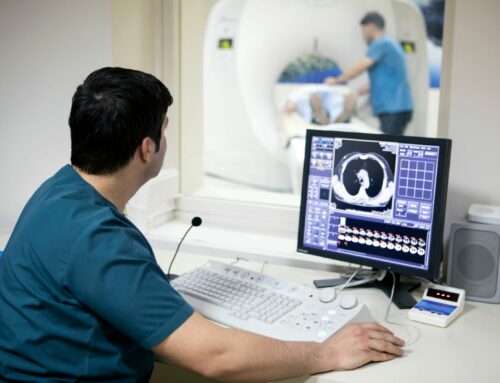By Shannon Burke, Senior Vice President and General Manager, Health Systems at Synchrony |
The US healthcare system is experiencing a fortuitously timed, data-powered technological revolution unseen in our history.
At the community level, it has enabled COVID-19 rapid response systems to mine online data sources for early disease detection in specific areas, use artificial intelligence tools for rapid case identification, and deploy digital contract tracing systems capable of interrupting community transmission.[i]
At the clinical level, 90%[ii] of office-based physicians and 81%[iii] of hospitals today have electronic health record (EHR) and electronic medical record (EMR) systems at their disposal. As a result, when patients visit their ER or doctor’s office with symptoms of COVID-19 or other serious medical conditions, a provider with access to a patient’s EHR is less likely to order expensive, duplicative tests or X-rays and more likely to tailor the correct medical intervention based on quick and easy access to the patient’s medical history.
For more than 23 years, I worked in senior technology roles focused on the interoperability of health systems, working to create ways for EHR platforms to seamlessly follow patients to different doctors at different medical touchpoints.
It’s hard to believe that it has been less than a decade since medical records were endless uncollated pages of raw data and contemporaneous provider scribbles. Or that these medical files – which had to be faxed or emailed around with no efficient way to synthesize the information therein – were the property of the provider, not the patient.
Passage of the Affordable Care Act, which included provisions facilitating medical data capture and sharing in ways that safeguarded patient privacy, was a watershed moment in health policy. We’ve achieved interoperability for doctors working in the same health system and are moving closer to the day when the broader health ecosystem can do the same – an achievement that would be nothing short of the “Holy Grail” for those of us who’ve dedicated our careers to improving digital health technology.
The digitization of medical records is helping to put patients in the driver’s seat of their health management. Today’s most frequently used EHR platforms put personal, up-to-date medical information at the fingertips of patients. They allow patients to see, study and share clinical records and lab results, schedule appointments, manage their medicines, and communicate directly with their care team.
Bringing Innovation to Healthcare Payments
We’re living through a new period in the evolution of our healthcare systems marked by more widespread patient engagement on platforms like WebMD, where ordinary Americans educate themselves about their medical problems and explore their health and wellness options.
Interestingly, however, these clinical innovations in healthcare have outstripped payment innovation. Two years ago, I transitioned from the clinical to the financial side of healthcare with the goal of changing that reality.
We know why payment innovation lags clinical innovation in the healthcare space. Until a few years ago, most healthcare payments were business-to-business transactions occurring in an opaque system between providers and third-party payers. But insurance cost-shifting and the proliferation of high-deductible plans has made the patient the new payer. Out-of-pocket health expenses for Americans now surpass $400 billion annually.[iv]
Before cost-shifting, patients did not hesitate to schedule medical appointments for problems large and small because someone else was picking up the tab. But now they’re assessing the value of health services like they do every other buying decision in their lives, balancing quality, cost and necessity before deciding on whether to move forward and with whom.
New patient portals have done a remarkable job at expanding their footprint and linking providers together. But not as much progress has been made in the effort to use these portals to help patients explore and access different payment options. Changing that will be good for providers and patients alike, because EHR integration means little if patients forgo the care they need for financial reasons.
We need to bring seamless financial engagement to patients, just as we have clinical engagement. Patients are not just comparing healthcare experiences against each other; they are comparing them to other digital payment experiences. In today’s environment, it’s difficult to separate the clinical and financial. Patients who have a clunky disjointed experience with payment may keep shopping around regardless of the quality of care. Part of my job is devising innovative ways to help patients and providers diversify payment options.
What we’ve found is that many healthcare consumers have never been exposed to patient financing options. When they become aware of their options, they are looking for confidence in their providers’ financial partners. The most evolved partners provide payment solutions that are already integrated into the most common EHR/EMR platforms.
We’ve also learned that many patients want to compartmentalize health expenses and are drawn psychologically to the idea of having a card on which only health, wellness and veterinary expenses are allowed.
Patient Portals as a Finance Tool
Patient portals are an important way hospitals and health systems can respond to consumer trends and demand for touchless payments by giving discerning health consumers greater confidence that they can pay back their medical bills over time in a manageable way, often on more favorable terms than a traditional credit card.
This summer, we entered a multi-year strategic partnership with a major health system. We are exploring other similar partnerships and are proud to offer a reliable payment option to their patients that empowers them to access the care they need, including pre-care, point-of-care and post-care.
For more than 30 years, Synchrony has been helping people pay for care not covered by insurance, including elective procedures, copays, deductibles and coinsurances. As a long-time warrior in healthcare’s digital trenches, I look forward to further digital integration in the future as hospitals and health systems, medical groups and all healthcare providers collaborate with payers and third-party financial partners to address the payment preferences of patients, especially those that are flexible, convenient, reliable and touchless.
 About The Author
About The Author
Shannon Burke is an industry veteran with more than 25 years of experience in the healthcare industry, particularly with technology startups, health insurance, pharmacy and managed care organizations. She joined Synchrony in December 2019 as Senior Vice President and General Manager, Health Systems. As the leader of the of the Business Development and Strategy teams for Synchrony’s Health and Wellness Platform, she helps lead the development and implementation of strategic and tactical imperatives to expand Synchrony’s offerings to health system clients, practitioners and healthcare technology partners.
[i] Digital technologies in the public-health response to COVID-19 | Nature Medicine
[ii] FastStats – Electronic Medical Records (cdc.gov)
[iii] Most Hospitals Use EHR Data to Support Quality Improvement Efforts (ehrintelligence.com)
[iv] National Health Expenditure Fact Sheet: Historical NHE, 2019, https://www.cms.gov/Research-Statistics-Data-and-Systems/Statistics-Trends-and-Reports/NationalHealthExpendData/NHE-Fact-Sheet, December 2020.












